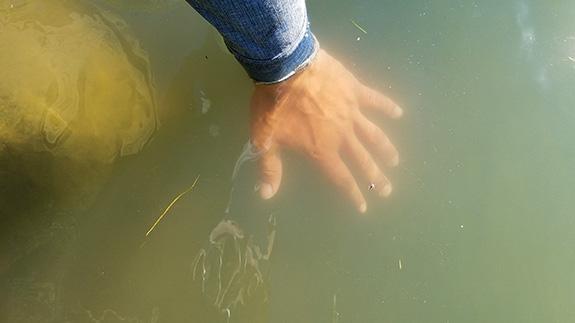Beaver Dammed
A fishery under threat.
With about 100 miles of floatable, wadeable, and fishable water, the Beaverhead River supports a strong local recreation economy—valued at nearly five million dollars annually—as boaters, fishermen, birders, and many others consistently visit this local treasure. The river also supports dozens of local ranches and farms. The important water and irrigation needs of the Beaverhead Valley and its residents prompted the government to long ago construct Clark Canyon Dam, which collects Red Rock and Horse Prairie creeks, in essence the headwaters of the Beaverhead. Unfortunately, this prize waterway—and the local economies, communities, and activities it supports—faces a growing threat.
For the past three summers, the Beaverhead has changed from clear and cool to cloudy, with its banks and eddies covered by intense algal blooms, including harmful blue-green algae, above and below Clark Canyon Dam. A leading theory suggests that low reservoir water levels, wind, and warmer temperatures have de-stratified the reservoir; i.e., surface-layer warm water has mixed with cold water at the lake’s bottom. This has churned up sediment, dead algae, and biomass, which is then pumped into the river. Local outfitters found the Beaverhead unfishable from Clark Canyon Dam to Barrett’s Diversion, from July well into September.
Since these pollution events began in 2014, several important things have happened. First, a hydropower company received permission to retrofit Clark Canyon Dam into a hydropower facility. Upper Missouri Waterkeeper filed a lawsuit to ensure that project’s licensure—which represents the only regulatory tool the state of Montana has to make sure operation of the dam doesn’t hurt the Beaverhead—protects downstream water quality and fisheries. That lawsuit’s settlement will help provide a transparent, accountable, and enforceable means for folks to work on the Beaverhead’s water-quality challenges in coming months and years.

Second, the local Beaverhead Watershed Committee, in partnership with Montana FWP and DEQ, has begun studying the science behind the Beaverhead’s annual pollution problems, all in an attempt to identify meaningful near-term solutions. A key take-away from that effort so far is that management of Clark Canyon Dam, which is controlled by the federal Bureau of Reclamation, is key to protecting the Beaverhead downstream. The unfortunate reality is that dams, whether new, old, or retrofitted with hydropower, all hurt our river’s natural health. In turn, solutions to dams’ impacts on our rivers aren’t simple or cheap.
The Beaverhead’s recent summer struggles represent a micro-analogy for the future of river management in Montana. With the reality of climate change, finite and variable water supply, and increasing demands on our rivers and landscapes, Montanans need to think outside the box about river conservation. We need to take an “all-of-the-above” approach to protecting our waterways; whether it is science and water efficiency, citizen education and action, lawsuits, legislation, or collaborative efforts, each tool and method has a valuable role to play.
The remaining challenge for the Beaverhead, as well as Montana’s other rivers, is whether we are willing to set our differences aside and, united, stand up for our waterways before it’s too late.
Upper Missouri Waterkeeper advocates on behalf of waterways in the Upper Missouri River Basin. Find out more at uppermissouriwaterkeeper.org.













